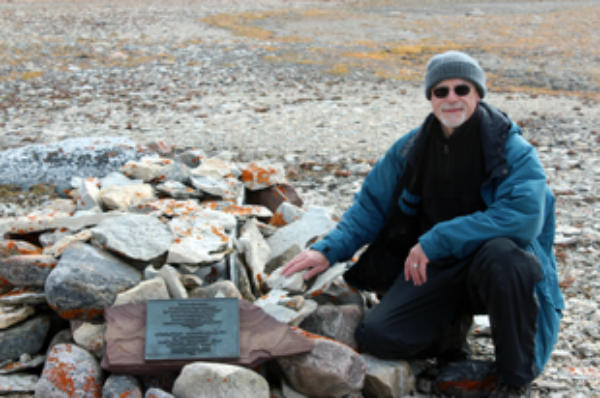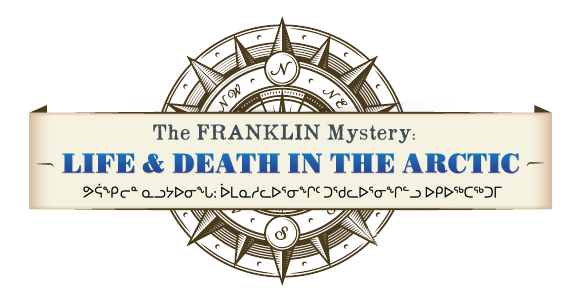Interpretive Essay by Douglas Stenton
 Douglas Stenton at Franklin commemorative cairn, Erebus Bay, King William Island.
(Photo by Robert Park).
Douglas Stenton at Franklin commemorative cairn, Erebus Bay, King William Island.
(Photo by Robert Park).
Bio: Douglas Stenton is an archaeologist by profession and the former Chief Archaeologist, and Director of Heritage for the Government of Nunavut Department of Culture and Heritage. Dr. Stenton has conducted archaeological research and training in the Nunavut since 1980. His research has focused primarily on settlement-subsistence systems of the late prehistoric (Thule) period, and since 2008 on the investigation of archaeological sites associated with the 1845 John Franklin Expedition.
Representing the Government of Nunavut, one of the original partners in Parks Canada’s search for the lost ships of the 1845 Franklin Expedition, between 2008 and 2016, Dr. Stenton directed the investigations of Franklin expedition archaeological sites on King William Island and Adelaide Peninsula. The work involved site surveys, excavations, and the preparation of detailed site maps, something which had never been done for most Franklin expedition sites. In 2014, his team made a discovery on a small island in Wilmot and Crampton Bay that proved to be instrumental to Parks Canada's discovery of Sir John Franklin’s ship, HMS Erebus.
Dr. Stenton retired from the Nunavut public service in 2017, and he is continuing to investigate the archaeology of the Franklin expedition. He and colleagues are currently conducting DNA analyses through which it is hoped that the skeletal remains of some expedition personnel might be identified, and analyzing the nearly 2,000 new artifacts that have been recovered from Franklin archaeological sites.
Dr. Stenton is an Adjunct Assistant Professor in the Department of Anthropology, University of Waterloo.
What do the discoveries of the wrecks, and your own knowledge and research, tell us about what happened to the Franklin Expedition?
The discoveries of the wrecks of HMS Erebus in 2014 and HMS Terror in 2016 were exciting and major events in Canadian history. They successfully concluded searches that began more than 160 years earlier, closed an important chapter of the Franklin mystery, and ushered in another. In and of themselves, the discoveries of the wrecks don't tell us what happened to the expedition; their importance lies in their condition and in their potential to provide new information that might be critical to achieving a fuller understanding of the expedition's history.
The wrecks could have been little more than ice-crushed debris scatters on the ocean floor, dashing any hopes for the survival of items that might help fill the many gaps in knowledge about what happened. HMS Erebus has suffered substantial damage, but both wrecks were found in remarkably good condition. This is important for several reasons, including the fact that the context of some of the artifacts may have been preserved. This could be especially important for the excavation of the wreck of HMS Terror, the location of which, unlike that of HMS Erebus, was apparently unknown to 19th-century Inuit and, thus, materials were not removed from the wreck. Both wrecks, however, contain information that has tremendous potential for improving our understanding of the final stages of the expedition.
What new questions come to mind?
The discoveries of the wrecks raise many questions, some new, some old. A fundamental question is determining, if possible, how the wrecks got to the locations where they were found, and how those events fit with what occurred on land. Was HMS Erebus actually re-manned and, if so, when, under what circumstances, and by how many men? If it was re-manned and under human control, how and why did it end up where it sank? The same questions apply to HMS Terror; were both ships re-manned at the same time and did they travel separately or in consort?
Other questions relate to what the wreck sites might tell us about what was happening on land. For example, is there a relationship between the camp found by Inuit at Terror Bay containing the corpses of a large number of Franklin's men, and the fact that HMS Terror sank there? Or could these events be unrelated, with the bodies being those of men who died en route to the Back River, and the Terror coincidentally drifting into and sinking at Terror Bay at a later date? Or, as might have happened with HMS Erebus, was HMS Terror also re-manned and deserted a second time at Terror Bay, resulting in the camp described by Inuit? The geographical settings of the wreck sites also present interesting questions. HMS Erebus is a considerable distance, about 70 kilometres south, of the track of the course of the retreat to the Back River. The wreck of HMS Terror, however, is situated directly along and roughly at the midpoint of the route. Whether any significance can be attached to this will depend on discovering new information, hopefully from the wrecks, about the circumstances under which each arrived at its respective location.
What information are you hoping will be revealed by archaeological excavations of the wrecks and more research?
The wrecks contain a wealth of information that will be of interest not only to archaeologists and historians, but also to scientists across a range of disciplines and subject areas, all of which will contribute directly or indirectly to a better understanding of the expedition. Our work focusses on the terrestrial archaeological record and about learning more about the nature of shore-based activities, and in particular, what happened to the men during the ill-fated journey to the Back River. An important part of our research involves DNA analysis through which we hope to be able to identify some of the men whose remains have been found at sites on King William Island and Adelaide Peninsula. Both wrecks are potential sources of DNA, and we hope that samples for analysis will be recovered as part of the long-term research design.
The condition of both wrecks is of special importance as it has renewed hopes about the survival of documentary evidence (e.g., ship’s logs, charts, journals) that might provide new information and details about the nature and timing of decisions and events that occurred. Personal journals would reveal not only what the men were experiencing, but how they tried to cope with the extreme circumstances that they were facing.
Surviving documents might also shed important light on a subject for which limited information currently exists. The testimony of 19th century Inuit has played and will continue to play a crucial role in the archaeology of the 1845 Franklin expedition, but little is known about the nature and extent of interactions between Inuit and the crews of the Erebus and Terror both before and after the desertion of the ships. Inuit oral history describes interactions that occurred while the ships were locked in ice in northern Victoria Strait, and a brief meeting near Washington Bay between a small group of Inuit and a group of officers and men en route to the Back River. Archaeological evidence from King William Island suggests that there was limited interaction prior to the meeting at Washington Bay, and records from the wrecks could play an important role in answering this question.
It should be noted, however, that if documents are found, and in salvageable condition, they will provide an incomplete picture. Certain documents might hold special importance by revealing the history of events up to April 1848, and the reasons for the decision to desert the ships, and to attempt to reach the Back River. What they probably cannot tell us, however, is how the plan to reach the Back River was actually executed. If one or both ships were re-manned, the reasons for that decision might be revealed, but many critical decisions affecting the final outcome were made after the ships were deserted and during the course of the journey to the Back River. This underscores the fundamental importance of the fact that the marine and terrestrial archaeological records of the expedition are linked and cannot be interpreted in isolation. The discoveries of the wreck sites are not only an exciting development with tremendous research potential for marine archaeologists, they also provide the opportunity to re-examine the terrestrial record of the Franklin expedition through a new lens.


